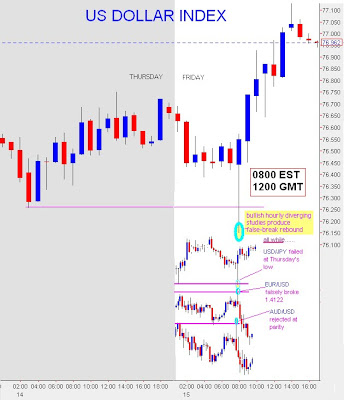
The dollar's recent correction was long overdue, and there are signs it could continue into next week.
The greenback has suffered mightily due to expectations about a second round of quantitative easing, or QE2, from the Federal Reserve. The dollar briefly touched on new 2010 lows after the release of Fed Chairman Ben Bernanke's speech on Friday, but the ensuing false-break recovery suggests that the currency market may have priced in QE2 fully, something the bond market also appears to have done.
Although the dollar's correction was overdue, speculators continue to ignore the fundamentals. In fact, dollar bears began the week accumulating fresh short positions on the back of renewed risk appetite.
Not only was Monday's dollar selloff short-lived, but China's decision to raise interest rates caught many traders off guard. Although the dollar index's (DXY) recovery technically is still considered corrective (so long as the index remains below the 79 handle), there is sufficient evidence that the correction can continue.
The dollar's rebound has already retraced a quarter of its losses since late August. Although this is considered a typical correction within a bear market move, the follow-through move early in Tuesday's North American session has confirmed the formation of a secondary swing pivot within the euro/dollar (EUR/USD), Australian dollar/dollar (AUD/USD), dollar/yen (USD/JPY) and gold.
A secondary swing pivot is characterized as a lower high within an uptrend or a higher low within a downtrend. Most turning points require the formation of a secondary swing to complete or consolidate the trend. Although it often takes a series of swing pivots to confirm a trend reversal, the latest price action is a promising sign for dollar bulls.
According to Elliot Wave analysis, the DXY has completed the third wave and has now entered the corrective fourth wave. The second wave was a simple three-wave correction. Thus, due to alternation, there is a high probability that the current correction could be complex. Meanwhile, the wave count will be altered only if the index moves higher than the 80 threshold. That would indicate a more meaningful rally would be in store.
Due to the lack of countermoves or corrective price action within the recent move, it's extremely important to watch key retracement levels. Oversold dips that exhibit bullish hourly divergence near the 38.2% retracement at 1.3560 in the EUR/USD will likely offer support
STRATEGY: BUY EUR/USD at 1.3560, risking 1.3505, targeting 1.4186























